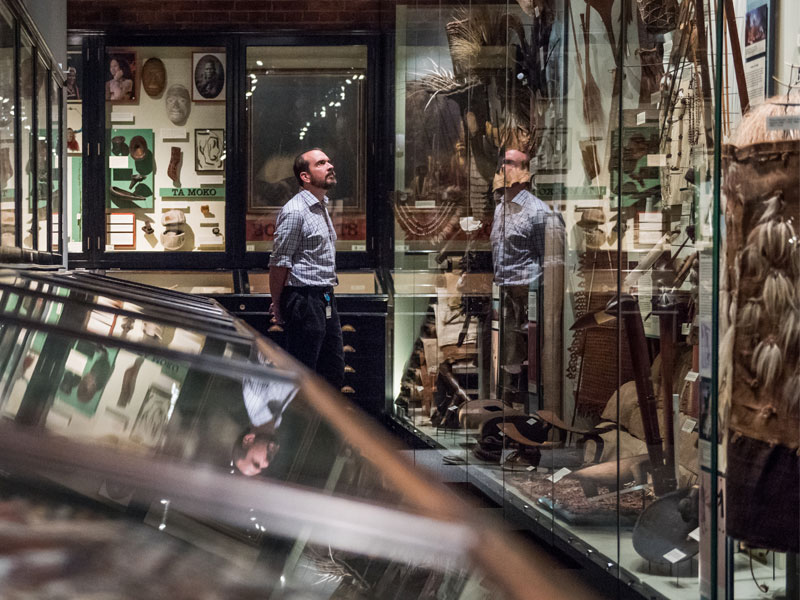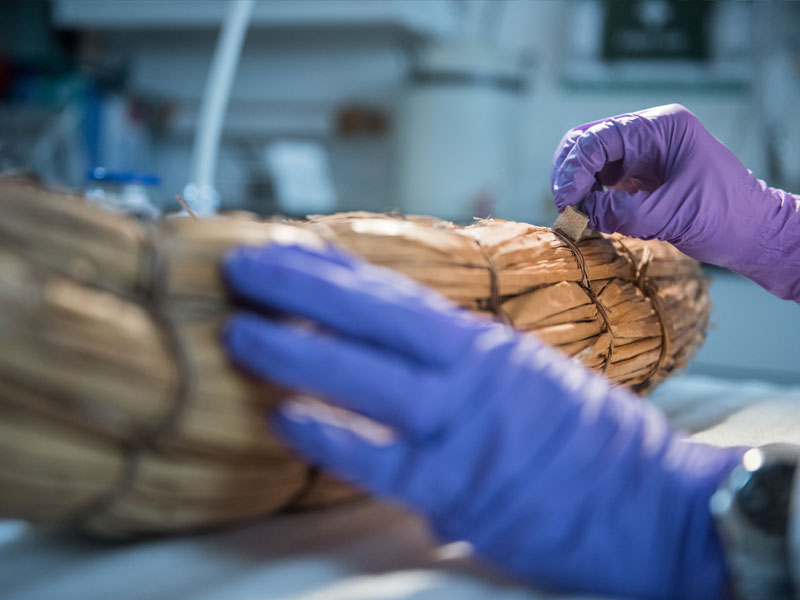‘It’s been an incredible privilege to have been able to work on those objects which were actually collected during Cook’s voyages and on-board the ship,’ enthuses Jeremy Uden, Deputy Head of Conservation at the Pitt Rivers Museum. He’s talking of course about Captain James Cook, the 18th-century explorer whose voyages in the Pacific, New Zealand and Australia transformed Western views of world geography.
Thanks to generous philanthropic support, artefacts collected on Cook’s first two Pacific voyages (1768 -1771 and 1772-1775) have gone on display in a new permanent exhibition at the museum. The final display represents more than 40 years of research by staff, and builds upon collaborations with academics, artists, scholars and students from around the world. ‘It’s absolutely been a collaborative effort,’ he notes.
For Jeremy, conserving the collection has been a two-year endeavour, involving many hundreds of hours of painstaking work. His approach, however, may not be quite what you’d expect. ‘We are ethnographic conservators here,’ he explains. 'We think about things slightly differently from other types of conservators, in that we have to consider the intangible aspects of objects too, and preserve things such as evidence of use.’ At the Pitt Rivers, this means ‘doing as little as possible to it, whilst making it stable enough to go on display and last another 250 years.’

In a collection of over 200 objects, it’s perhaps not surprising to learn that some artefacts required a little more work than others. ‘I suppose the biggest challenge was the feather cape to the Tahitian mourner’s costume,’ he says. It had been badly moth damaged after spending years stored in the basement of the old Ashmolean, and in the end required over 150 hours of careful conservation work to repair the cloak’s delicate feather bundles.
The costume was collected on Cook’s second voyage, although we know from records that Joseph Banks – the naturalist and explorer who accompanied Cook on his first adventure in 1768 – actually took part in the funerary ceremony. He ‘had his body blackened with burned candle nut, and acted as one of the chief mourner’s retinue,’ explains Jeremy.
‘We know that it’s all about status,’ he continues. The red, yellow and black stripes used on the barkcloth cape were colours reserved for high-ranking individuals, and the tropicbird feathers surrounding the mask – of which there are hundreds – could only have been collected by being ‘lowered down a cliff to the bottom where the birds nest.’ Each costume would have also featured between five and ten valuable pearl shells. Not found on Tahiti, the shells were traded commodities, each with the value of a pig.

This fine example of Polynesian ceremonial dress is ‘arguably the most complete’ of the five or six that remain today, providing the museum with a unique opportunity to re-interpret the costume through its display. By presenting it as a full three-dimensional ensemble, Jeremy and the team hoped to illustrate the decorative scale and social status of the Chief Mourner during the elaborate ceremony – but, at an imposing 2.7meters in height, the question was ‘how’?
Thankfully, philanthropy enabled the purchase of a custom-made case, and collaboration with V&A textiles conservator and mount-maker Rachel Lee (more used to working on French ball gowns than 18th-century barkcloth) presented the perfect solution. ‘Certainly, I’ve never seen one displayed on a mannequin in 3D to give that other-worldly impression that you see in the contemporary illustrations,’ says Jeremy. ‘I think it’s quite important actually – you can visualise what it might be like to see the Chief Mourner on Tahiti. Lots of people have said to me “oh gosh, he must have been so hot in all those layers of barkcloth!”’
This is what people were wearing and using in their everyday activities, virtually before Westerners came into the area.Jeremy Uden
Now fully conserved, the collection as a whole serves as an ‘incredibly important’ record of pre-contact material culture in the Pacific. ‘This is what people were wearing and using in their everyday activities, virtually before Westerners came into the area,’ he says. After Western contact, the culture of the Pacific changed dramatically: the introduction of iron, for example, meant that stone or shark’s tooth tools were no longer used. ‘Every facet of life was affected by Western contact.’
But while the Cook-Voyage Collection undoubtedly opens a window onto an unfamiliar world, there are many things about pre-contact Polynesian culture that we still do not understand. ‘Some of the meaning of the things they collected is lost,' explains Jeremy. 'For example nobody really knows what the ceremony behind the mourner’s costume meant, what the significance of the costume is – there are lots of theories, but that has been completely lost on Tahiti now.’
Jeremy, however, remains hopeful. The museum hosts regular visits from originating communities, seeking to reconnect with their own culture through the objects on display or in storage. ‘I think that there are lots of questions […] that maybe we will find out the answers to when originating cultures make contact. They’re able to tell us a lot about the objects, how they’re used and their significance – and I’m sure there’s a lot more to learn.’
The re-display of the Cook Voyage Collection has been made possible thanks to generous support from the Clothworkers’ Foundation, following the award of a Conservation Fellowship to Jeremy Uden.
Further support from the DCMS Wolfson Museums and Galleries Improvement Fund, and the Friends of the Museum, enabled the purchase of the custom-made case in which the collection is now displayed.